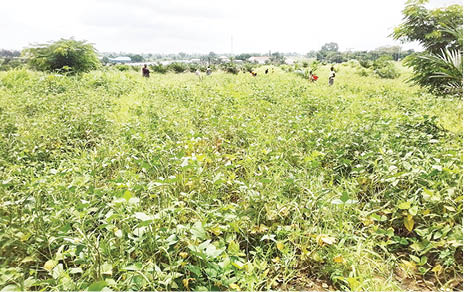Experts have suggested a step-by-step guide for farmers in Benue State as rain-fed cowpea (beans) planting approaches.
The experts, from the University of Agriculture, Makurdi (FUAM) now called Joseph Sarwuan Tarka University, Makurdi (JOSTUM) in Benue State, outlined best practices that the cowpea farmers can imbibe to ensure bountiful harvest.
One of them, a seed systems specialist, Prof. Lucky Omoigui, said firstly, it is crucial for farmers to select well-drained land and avoid lowland plains prone to waterlogging.
He said that proper land preparation, including ploughing and harrowing, remain essential to create a fine seedbed for better seed-soil contact and water retention, stressing that farmers should source high-quality seeds from reputable seed companies and acquire chemicals (insecticides and herbicides) and fertilisers from reliable sources.
- Taraba farmers count losses as crops dry off
- Largest diamond in over a century discovered in Botswana
Omoigui also advised that from land preparation to harvest, the farmers must select well-drained, fertile soil with good organic matter content and avoid waterlogged areas as cowpeas do not tolerate excess moisture. He also urged them to clear the land of weeds, stumps and previous crop residues and perform primary tillage by ploughing to a depth of about 15-20 centimetres to loosen the soil.
He added that they should harrow the land to break down soil clumps, improving seed-soil contact and water retention while in waterlogged areas, they should create ridges for better drainage; otherwise, flatbeds are sufficient in well-drained soils and use a hoe or tractor to make ridges spaced 75 centimetres apart.
The scientist further advised farmers to choose cowpea varieties that are well-suited to the local climate and soil conditions, and resistant to prevalent pests and diseases. They suggested popular varieties such as; FUAMPEA 1, FUAMPEA 2, FUAMPEA 3, FUAMPEA 4, SAMPEA 14, and SAMPEA 19 and the treatment of the seeds with appropriate fungicides and insecticides, such as Apron Star, to protect against soil-borne diseases and insect pests.
Omoigui said the farmers can plant twice within the season: early in the rainy season (May to June) and in the late season (August) when the soil moisture is sufficient.
He said for the early maturing varieties like FUAMPEA 1, farmers can plant at the beginning of the rainy season and again in late August, with a space seeds of 20-25 centimetres apart within rows spaced 75 centimetres apart, and plant at a depth of 2-4 centimetres.
Omoigui, a professor of Plant Breeding and Genetics who developed the FUAMPEAs at JOSTUM, said the farmers should plant three seeds per hole to ensure good plant stand, thinning to two plants per stand after all seeds have germinated.
An agronomist, Dr Teryima Iorlamen, noted that selecting the right site remains crucial, advising that for rain-fed cowpea, farmers should choose a well-drained sandy loam soil, while for dry-season crops, using residual moisture, inland depressions or areas near lake shores are ideal.
He said, “Cowpea cannot thrive in overly wet or waterlogged conditions. So avoid poorly drained soils. When preparing the land, clear any shrubs and stubble, or alternatively, apply Glyphosate (Round-up) at 4 litres per hectare and allow 10 days for weeds to die off.
“Land can be prepared manually with an African hand-hoe or by using a tractor to plough and harrow, ensuring no soil barriers like hardpans. Proper land preparation encourages good germination and reduces weed problems. Ridges can be made if desired, but in areas prone to erosion, minimum or zero tillage is advised.
“Planting time is key as it influences seed yield, quality and insecticide use. High yields of quality seeds are achieved when cowpea matures in dry weather.
“In Northern Nigeria, cowpea reproductive development depends on photoperiod, with some varieties being sensitive and others insensitive to day length.
“For photoperiod-sensitive varieties, planting in late July to mid-August is ideal to ensure early flowering and avoid excessive vegetative growth, which can reduce yields. “Photoperiod-insensitive varieties can be planted any time provided there is adequate rainfall or irrigation.”
Iorlamen explained that cowpea doesn’t need much nitrogen fertiliser as it fixes its own nitrogen, but that poor soils may require a small starter dose of 15 kilogrammes per hectare of NPK 15:15:15, emphasising that excess nitrogen leads to lush growth but poor grain yield.
“Cowpea needs more phosphorus, around 30 kilogrammes per hectare of SUPA, to ensure good nodulation and nitrogen fixation. A soil test is recommended for determining precise nutrient needs. Weed management is essential, as weeds compete for resources and harbour pests, especially in the first 5–8 weeks after planting. Weed control can be manual, mechanical, or chemical, depending on the specific problem and available resources,” he stated.
Prof. Omoigui further said weeds compete with cowpeas for nutrients and sunlight, therefore the need to use manual or mechanical methods to control them cannot be overemphasised.
He urged farmers to conduct the first weeding two-three weeks after planting and a second weeding around five-six weeks after planting or alternatively, use post-emergence herbicides like Raptor or Legume Force, applying them three weeks after planting.
“For fertiliser application: apply phosphorus-based fertilisers (e.g., Single Super Phosphate) at planting. Cowpea, being a legume, generally does not require nitrogen fertiliser as it fixes its own nitrogen. However, a starter dose of NPK 15:15:15 may be applied, especially when planting on new land.
“Regularly inspect crops for pests like aphids, thrips, cowpea pod borer (maruca), and pod-sucking bugs. Early detection is key.
“Use appropriate insecticides, such as Imiforce for aphids, and insecticides containing Cypermethrin plus Dimethoate for thrips, maruca, and pod-sucking bugs. The concentration of Dimethoate should be higher than that of cyclimethrin (250 to 300 G/L EC).
“Rotate crops to reduce disease pressure, and avoid planting cowpeas on the same land year after year to prevent the buildup of soil-borne diseases.
“Harvest cowpea when the pods turn yellow and are fully mature and dry, typically 70-85 days after planting, depending on the variety.
“Handpick the pods and spread them on a clean surface to dry, reducing moisture content. Once the pods are fully dry, thresh them to separate the seeds, either manually or using mechanical threshers.
“Thoroughly dry the seeds under the sun to reduce the moisture content to around 12-13 per cent before storage. Proper drying prevents mould and insect infestation.
“Store dried seeds in clean, airtight containers or bags (e.g., PICS bags). For long-term storage, treat seeds with insecticides like phosphine tablets to prevent storage pests like weevils.
“Ensure the phosphine is wrapped in paper or cloth and not applied directly to the seeds. If selling, ensure that seeds are high quality, free from contaminants and meet market standards. Selling during periods of low supply can fetch higher prices,” Omoigui also stated.
He, however, stressed that selecting the right cowpea variety nowadays becomes critical for good yields, considering climatic conditions, and advised farmers to obtain certified seeds from reputable sources like agricultural research institutes or accredited seed companies in Benue State.
“Varieties like FUAMPEA 1 (extra early maturing), SAMPEA 14, SAMPEA 19 (early maturing), and FUAMPEA 2, 3, 4 (medium maturing) are recommended based on the area’s rainfall patterns. Farmers should use insecticides like Imiforce during the early vegetative growth stage to control pests such as aphids.
“Additionally, chemicals like Lambda-cyhalothrin, Dimethoate, and cytomethrin are effective against a wide range of pests, especially during flowering and podding stages. Always follow label instructions for proper application. Ensure proper weeding, use appropriate insecticides to control pests, and follow good agronomy practices. Timely harvesting is also crucial—avoid letting the cowpea to over-dry in the field,” Prof. Omoigui added.

 Join Daily Trust WhatsApp Community For Quick Access To News and Happenings Around You.
Join Daily Trust WhatsApp Community For Quick Access To News and Happenings Around You.


